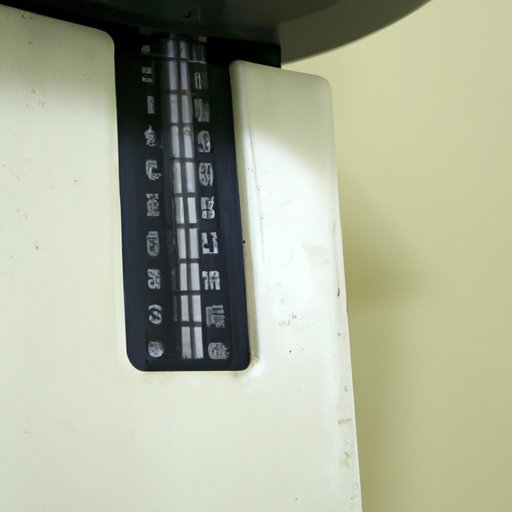
Introduction
When we say “weight,” we are usually referring to the amount of matter or substance in an object or person. Measuring weight is an essential part of our everyday lives, from measuring ingredients when cooking to knowing how much we weigh on a scale. This article provides a comprehensive guide on weight measurement, including the basics of weight measurement, the science behind weighing, the different units of weight measurement, the use of weight in everyday life, the history of weight measurement, common misconceptions about weight measurement and how to choose the right scale for your needs.
Understanding the Basics of Weight Measurement: A Comprehensive Guide
Weight is a force that is exerted by an object under the influence of gravity. The weight of an object is commonly expressed in terms of units such as kilograms, pounds, grams, and ounces. It is important to understand the difference between weight and mass. While weight is determined by the pull of gravity on an object, mass represents the amount of matter that is in an object. Mass remains constant regardless of gravitational influence.
To ensure that weight measurements are uniform, standardized units must be used. The International System of Units (SI) is the most commonly used unit system for measurements globally, with its standard unit of weight being the kilogram. Although the United States typically uses pounds as its standard unit, the metric system is becoming more widely accepted across the world.
The Science of Weighing: How We Measure Weight and Why It Matters
The simple act of using weighing scales to measure an object’s weight seems effortless, but the science behind it is more complex. When an object is placed on a weighing scale, it exerts a force on the scale. The scale measures this force by sensing the distortion of its internal structure and produces a weight reading.
Accurate weight measurement is crucial in various applications, including health, commerce, and transportation. In the health industry, weight is used to track body burden, diagnose diseases, and monitor medication or therapy regimes. Commercially, weight is used as a standard measure when selling products, calculating shipping costs, and determining nutritional content. Transportation depends on accurate weight measurement to ensure that the cargo on board is distributed safely, avoiding the risk of overloading.
From Ounces to Pounds to Tons: Exploring the Different Units of Weight Measurement
Weight measurement units vary depending on their intended application. For instance, the smallest unit of measurement that is widely used is the ounce, while the largest is the ton. The conversion between units is straightforward and can be achieved using mathematical formulas. For example, one pound is equal to 16 ounces, and one ton is equal to 2,000 pounds.
Different units of weight come in handy in different situations. For instance, in cooking, ingredients are measured in ounces or grams, while farmers use pounds to measure livestock and crops. The ton is mostly used in shipping and manufacturing, where the weight of cargo and equipment is substantial.
Why Weight Matters in Everyday Life: How to Accurately Measure Your Food, Body and More
Weight measurement is a crucial tool in maintaining a healthy lifestyle. For example, when cooking or baking, measuring ingredients by weight is more accurate than using volumetric measurements. Weight measurements are also essential when counting calories, tracking dietary intake, and determining suitable portion sizes. When monitoring body weight, tracking weight progress by numbers rather than relying on intuitive feelings provides a better metric for long-term progress management.
The History of Weight Measurement: How We’ve Evolved from Ancient Methods to Modern Technology
Humans have been measuring weight through various methods since ancient times. Units like the shekel and talent were used in the Babylonian empire for trade and tax purposes. The Romans used the pound, which continued to be commonly used until the 20th century. With the growth of modern technology, more precise and reliable measuring tools have been developed. First, the balance scale was invented, followed by the spring scale and digital weighing scales.
Common Misconceptions About Weight Measurement: Debunking the Myths and Setting the Record Straight
There are various misconceptions surrounding weight measurement. One common myth is that a person’s body weight is the most accurate representation of their physical fitness and health. This is not always the case since body composition, bone density, and muscle mass can affect the accuracy of body weight measurements. Another misconception is that the weight indicated by the scale is an accurate representation of an object’s absolute weight, which is not true because weight can vary depending on the gravitational field and the weighing instrument used.
Choosing the Right Scale for Your Needs: A Guide to Buying and Using Weighing Equipment
The choice of a weighing scale should depend on its intended use. There are various types of scales available today, including those for personal use, commercial use, and laboratory use. Some factors to consider when choosing a weighing scale include accuracy, precision, readability, and cost. Proper use and care of the scale are also necessary for accurate weight measurement.
Conclusion
Understanding weight measurement is an essential part of our everyday lives. Inaccurate weight measurements can lead to health problems, commercial discrepancies, or cargo accidents, among others. This article covered various aspects of weight measurement, from understanding the basics of weight measurement to the science behind weighing, different units of weight measurement, the importance of weight in everyday life, and the history of weighing. By applying this knowledge, we can make better-informed decisions that will have a significant impact on our lives.





